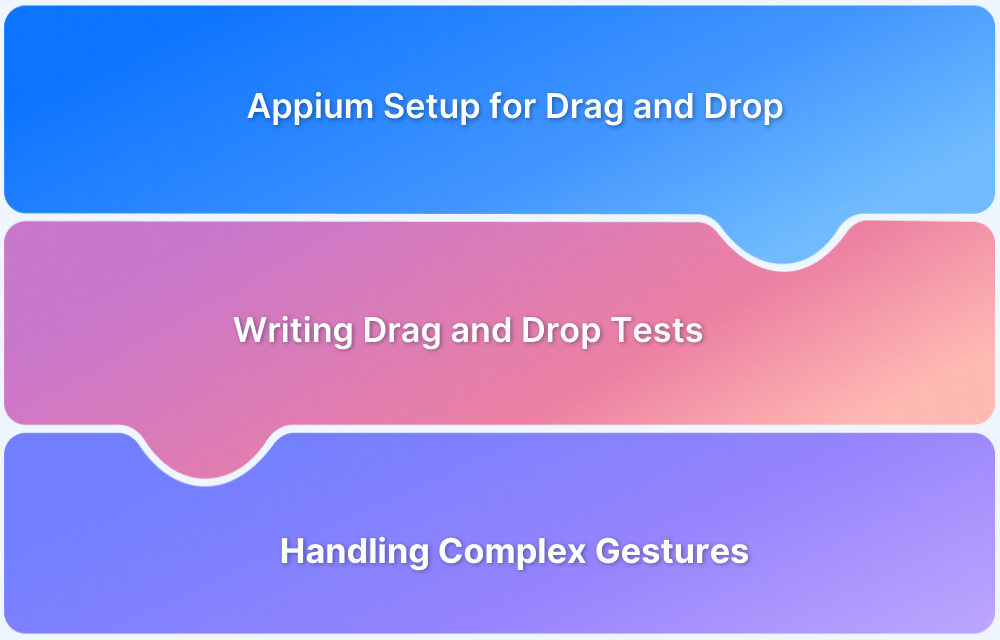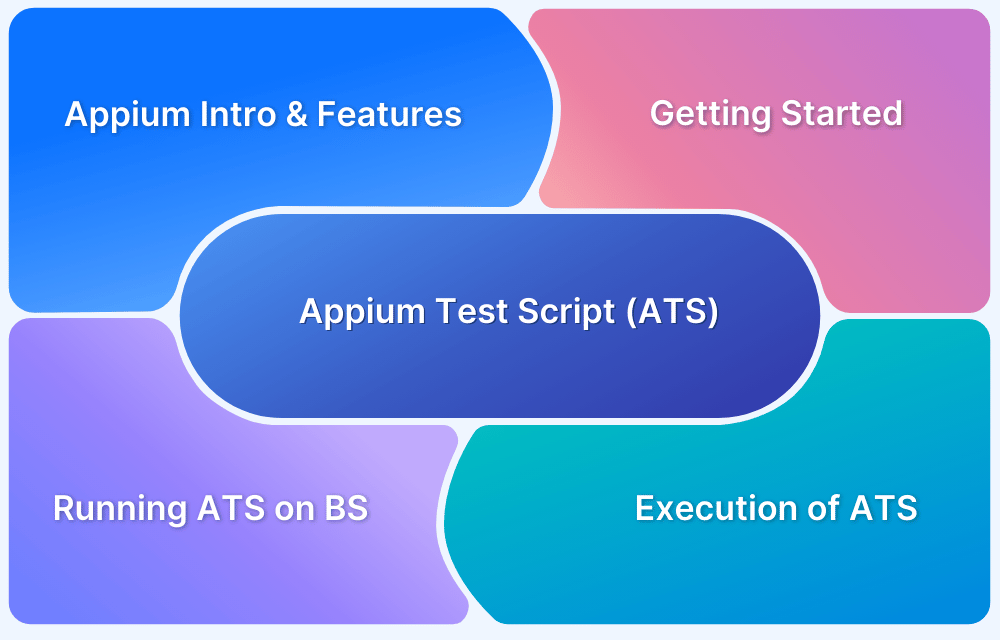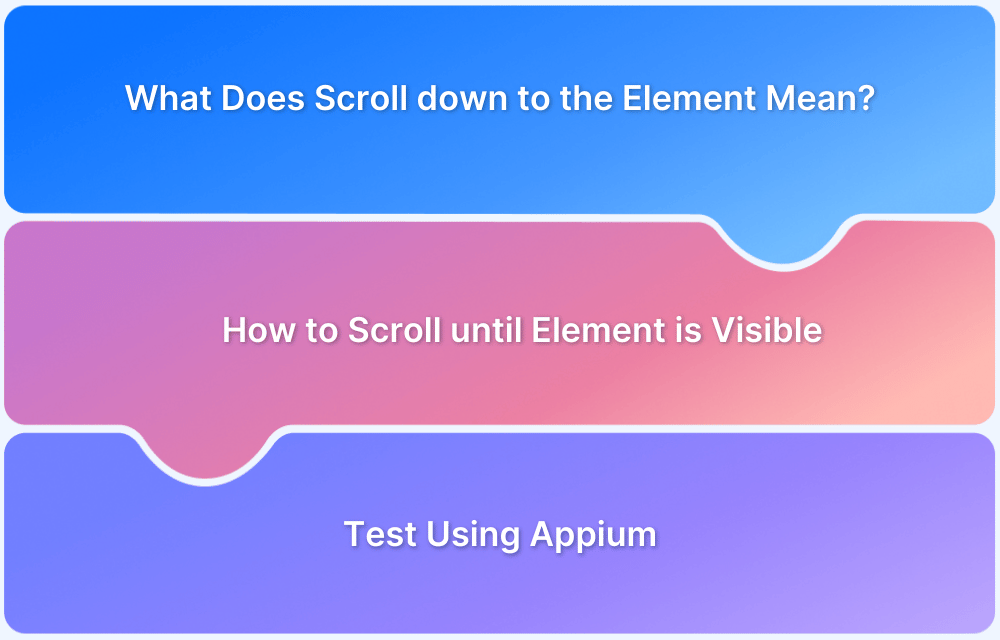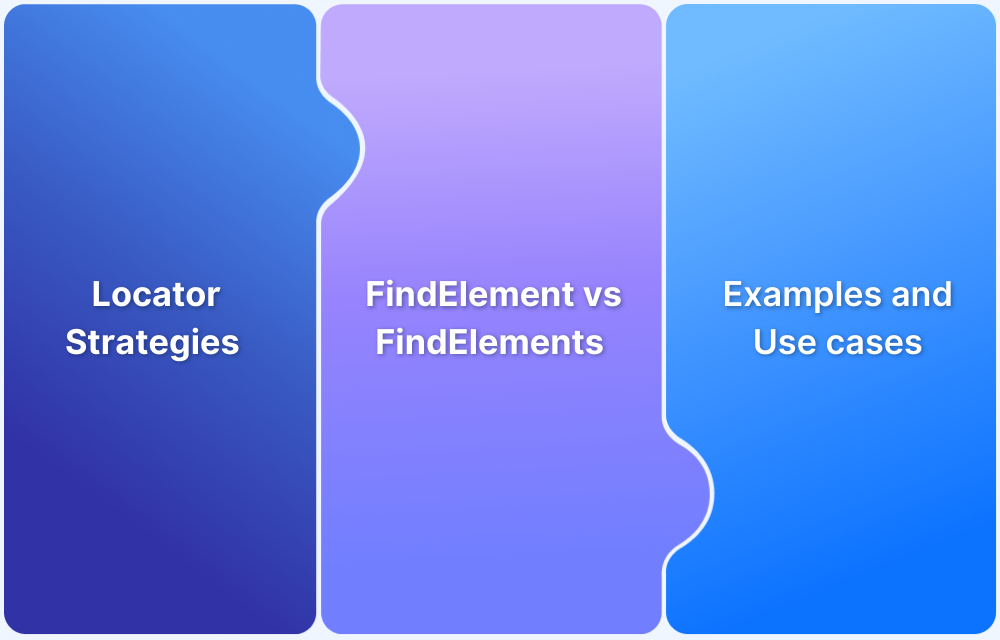Drag and drop in Appium is one of the most common gesture automation scenarios for mobile apps. From moving stickers in Instagram stories to rearranging items in a shopping app, users rely on drag-and-drop functionality daily. Automating these gestures ensures a smooth experience across devices and OS versions.
Overview
What is Drag and Drop in Appium?
- Gesture automation technique combining press, move, and release actions.
- Supported through TouchAction API in Appium.
- Allows replicating real user behavior like swiping, dragging, and repositioning elements.
Prerequisites for Automating Drag and Drop
- Appium Desktop Client and Appium Inspector.
- JDK installed and configured.
- IDE like Eclipse or IntelliJ.
- Test dependencies set up (Appium client libraries, drivers, APK under test).
How to Automate Drag and Drop in Appium
- Identify element to drag → Use locator strategy (ID, XPath, etc.).
- Long press element → Initiate gesture using TouchAction.longPress().
- Move to target location → Define coordinates or target element.
- Release and perform → Finalize action with release().perform().
- Run test → Validate execution in local setup or cloud environment.
This article explains how to perform drag and drop in Appium — from prerequisites and step-by-step automation with TouchAction to validating results on real devices using BrowserStack.
Drag and Drop using Appium
As most of us are aware of how powerful Appium is for automation testing, it is important to know that the same tool provides us with some excellent advanced features and functions which makes it possible to automate most of the use cases. Drag and drop too can be automated easily by Appium. It provides “TouchAction” object to automate and perform these mobile gestures. TouchAction objects contain a chain of events.
In all the Appium client libraries, touch objects are created and are given a chain of events. The available events are press, release, move to , tap, wait, long press, cancel and perform.
Prerequisites to perform Drag and Drop using Appium
- Appium desktop client
- Appium Inspector
- JDK
- Development IDE/Eclipse
Steps to automate Drag and Drop using Appium
To automate drag and drop using Appium TouchAction, the following steps are executed:
- The element to be dragged is identified and being long pressed.
TouchActions action = new TouchActions(driver); action.longPress(element);
- It is then moved to the desired location by getting the location coordinates of both drag and drop locations.
TouchActions action = new TouchActions(driver); action.down(10, 10); action.moveTo(50, 50);
- Element is released to the location and the action is performed.
TouchAction action = new TouchAction(driver); action.press(10, 10); action.moveTo(10, 100); action.release(); action.perform();
Ensure that you have all the tools installed in your system.In this example, a sample APK is used to demonstrate Drag and Drop automation. You can take your app under test or any sample application to understand and implement the same. Make sure that you have all the Appium and testing dependencies configured on your system.
Pro Tip: You can use BrowserStack’s Capabilities Generator for Appium to add all the capabilities
Java code to execute Drag and Drop action
package testing;
import java.net.URL;
import java.util.List;
import java.util.concurrent.TimeUnit;
import java.util.function.Function;
import java.net.MalformedURLException;
import io.appium.java_client.MobileBy;
import io.appium.java_client.android.AndroidDriver;
import io.appium.java_client.android.AndroidElement;
import org.openqa.selenium.support.ui.ExpectedConditions;
import org.openqa.selenium.support.ui.WebDriverWait;
import org.openqa.selenium.WebDriver;
import org.openqa.selenium.remote.DesiredCapabilities;
import org.testng.annotations.Test;
import io.appium.java_client.TouchAction;
import io.appium.java_client.touch.WaitOptions;
import io.appium.java_client.touch.offset.PointOption;
import java.time.Duration;
import org.openqa.selenium.By;
public class Dragdrop {
@Test
public void DragandDrop() {
try {
DesiredCapabilities caps = new DesiredCapabilities();
caps.setCapability("deviceName", "Google pixel 4"); //Give your device/emulator name
caps.setCapability("udid", "emulator-5554"); // Go to adb location i.e. C:\Users\singe\AppData\Local\Android\Sdk\platform-tools in command prompt and execute ‘adb devices’ to get udid
caps.setCapability("platformVersion", "8.1.0"); //Give android version of your device. (Check ‘about phone’ section)
caps.setCapability("appPackage", "dragdrop.stufflex.com.dragdrop"); //provide app package name. Apkinfo can be used or execute dumpsys window windows | grep -E ‘mCurrentFocus’ command in adb shell in cmd in C:\Users\singe\AppData\Local\Android\Sdk\platform-tools
caps.setCapability("appActivity", "dragdrop.stufflex.com.dragdrop.MainActivity");
AndroidDriver driver = new AndroidDriver(new URL("http://127.0.0.1:4723/wd/hub"), caps); //Create driver object
driver.manage().timeouts().implicitlyWait(10, TimeUnit.SECONDS); //Implicit wait of 10 seconds
driver.findElement(By.id("dragdrop.stufflex.com.dragdrop:id/btn_football")).click();
AndroidElement a=driver.findElementByXPath("//*[contains(@text,'Barcelona')]");
AndroidElement b=driver.findElement(By.id("dragdrop.stufflex.com.dragdrop:id/answer"));
TouchAction action =new TouchAction(driver);
action.longPress(PointOption.point(a.getLocation().x, a.getLocation().y)).waitAction(WaitOptions.waitOptions(Duration.ofSeconds(1)))
.moveTo(PointOption.point(b.getLocation().x, b.getLocation().y)).release().perform();
Thread.sleep(10000); //wait of 10 seconds
driver.quit(); //closes the driver session
} catch (Exception e) {
// TODO Auto-generated catch block
e.printStackTrace();
}
}
}The above code uses a drag and drop quiz app which automates the process of choosing the quiz “category”, drags the correct answer option and drops it to the answer submission space which results in passing off the first question successfully and takes the user to the next quiz question..
Inorder to get accurate results and to not leave a room for any bugs/performance issues later, it is always recommended to perform real device cloud testing on different combination of operating systems, versions, and screen sizes. This ensures your app works flawlessly on every user’s mobile regardless of which mobile device, OS or OS version that your users they use. Browserstack provides the platform to test both web and mobile apps on multiple available options to choose from. Automation tests can be run on app automate by following the steps.
Code after integration with Browserstack
package testing;
import java.net.URL;
import java.util.List;
import java.util.concurrent.TimeUnit;
import java.util.function.Function;
import java.net.MalformedURLException;
import io.appium.java_client.MobileBy;
import io.appium.java_client.android.AndroidDriver;
import io.appium.java_client.android.AndroidElement;
import org.openqa.selenium.support.ui.ExpectedConditions;
import org.openqa.selenium.support.ui.WebDriverWait;
import org.openqa.selenium.WebDriver;
import org.openqa.selenium.remote.DesiredCapabilities;
import org.testng.annotations.Test;
import io.appium.java_client.TouchAction;
import io.appium.java_client.touch.WaitOptions;
import io.appium.java_client.touch.offset.PointOption;
import java.time.Duration;
import org.openqa.selenium.By;
public class Draganddrop {
public static void main(String[] args) throws MalformedURLException, InterruptedException {
DesiredCapabilities caps = new DesiredCapabilities();
// Set your access credentials
caps.setCapability("browserstack.user", “user name”);
caps.setCapability("browserstack.key", "access key");
// Set URL of the application under test
caps.setCapability("app", "bs://a03d62880214a159613f30ab467c3132702d32d8"); //unique app url generation for the app under test
// Specify device and os_version for testing
caps.setCapability("device", "Samsung Galaxy A52");
caps.setCapability("os_version", "11.0");
// Set other BrowserStack capabilities
caps.setCapability("project", "First Java Project");
caps.setCapability("build", "browserstack-build-1");
caps.setCapability("name", "first_test");
AndroidDriver<AndroidElement> driver = new AndroidDriver<AndroidElement>(
new URL("http://hub.browserstack.com/wd/hub"), caps);
driver.manage().timeouts().implicitlyWait(10, TimeUnit.SECONDS);
driver.findElement(By.id("dragdrop.stufflex.com.dragdrop:id/btn_football")).click();
AndroidElement a=driver.findElementByXPath("//*[contains(@text,'Barcelona')]");
AndroidElement b=driver.findElement(By.id("dragdrop.stufflex.com.dragdrop:id/answer"));
TouchAction action =new TouchAction(driver);
action.longPress(PointOption.point(a.getLocation().x, a.getLocation().y)).waitAction(WaitOptions.waitOptions(Duration.ofSeconds(1)))
.moveTo(PointOption.point(b.getLocation().x, b.getLocation().y)).release().perform();
// Invoke driver.quit() after the test is done to indicate that the test is completed.
driver.quit();
}
}Test results can be viewed on App Automate Dashboard once the test execution is completed. By clicking on individual tests will give you a detailed report for each test including steps, text logs, Appium logs, execution video logs, and other details for better debugging of failed tests.





